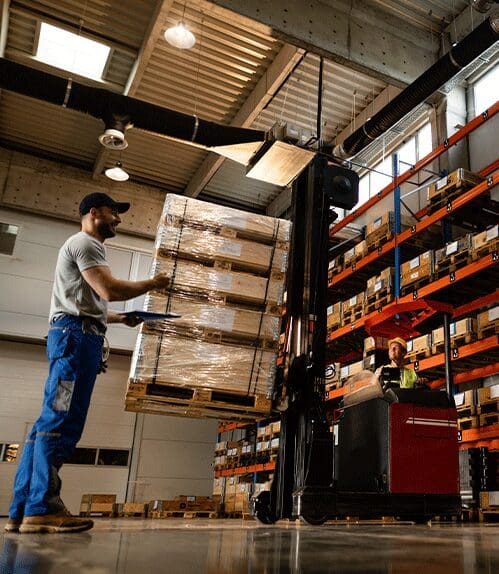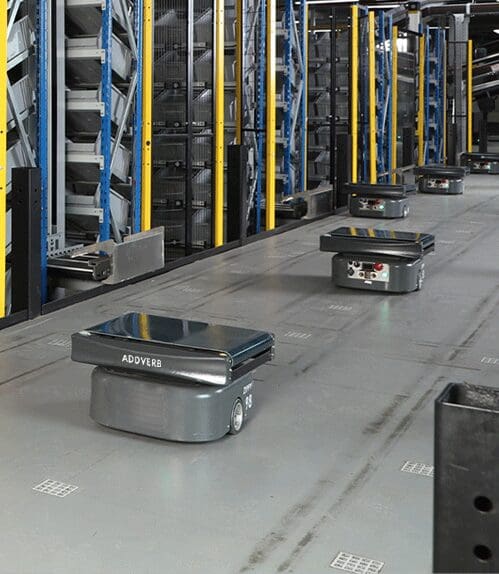Table of Contents
Read through the blog to unravel the essence of what a warehouse floor plan is, delve into the key considerations for its design, and explore a step-by-step guide on how to create an effective and efficient layout.
In our exploration of creating the ultimate warehouse floor plan, we’ll dive into the essentials of optimizing space, streamlining workflows, and harnessing cutting-edge warehouse automation technologies. From defining your operational goals to implementing advanced planning tools, we’ll guide you through each step to transform your warehouse into a model of efficiency and productivity.
Let’s embark on this journey to efficiency together!
What is a warehouse floor Layout?
A warehouse plan/ layout refers to a strategic arrangement of the physical spaces within a warehouse designed to optimize various operations such as shipping, storing, picking, and packing goods. A warehouse plan helps to enhance space utilization, improve work efficiency, and support streamlined workflows, which helps warehouse operators meet their goals. There is no universal warehouse floor plan/layout that works for all warehouse operations; however, several practices can be kept in mind to enhance warehouse efficiency and operations.
Key Objectives of a Warehouse floor Plan/Layout
We will examine the main goals of a warehouse plan or layout in this section. A strategic warehouse layout aims to maximise productivity, safety, and efficiency by designing an environment that goes beyond just arranging shelves and items in a given area. Warehouse managers can create a plan that not only satisfies the demands of their operations today but also looks ahead to future requirements by comprehending and ranking these goals. Let’s examine the basic objectives that guide the planning and structuring of a successful warehouse layout.
- Maximize Space Utilization: Efficient use of available vertical and horizontal space to accommodate as much inventory as possible without compromising accessibility or safety.
- Enhance Work Efficiency: Design the layout to minimize the time and effort required for workers to complete their tasks, thereby increasing productivity.
- Streamline Workflows: Arrange the warehouse in a way that logically flows from inbound to storage places to outbound and shipping, reducing bottlenecks and improving speed.
- Ensure Safety: Prioritize the safety of personnel by minimizing the risk of accidents through clear signage, well-marked walkways, and adherence to safety regulations.
- Adaptability: Design the layout to be flexible enough to adapt to changes in inventory levels, product lines, or operational strategies.
The Role of Automation in Warehouse Layout Optimization
Automation is pivotal in optimizing warehouse layout by integrating state-of-the-art technologies to streamline operations, reduce redundant tasks, increase work safety, and minimize errors. They adjust according to inventory levels, demand patterns, and operational priorities, ensuring optimal utilization, enhancing data analysis and accuracy, and operational efficiency.
| Warehouse Automation Trends in 2024 Selecthub highlights warehouse automation trends in 2024, noting that mobile robots, including AMRs (Autonomous Mobile Robots) and AGVs (Automated Guided Vehicles), are demonstrating growth rates of 24% and 43%, respectively. Between 2032 and 2042, the market for mobile robots is anticipated to grow to a value of over $334 billion. According to estimates, the worldwide market for IoT in warehouse management will reach $27.79 billion by 2030, up from $12.13 billion in 2023. The global ASRS market is estimated to grow from $8.7 billion this year to $12.07 billion by 2028, with a CAGR of 7.9%. |
Creating an Efficient Warehouse Floor Plan: A Step-by-Step Guide
This section will delve into comprehensive steps designed to help you create an efficient warehouse floor plan. Join us as we explore the key steps to transforming your warehouse into a highly efficient and productive operation.

Step 1: Define Operational Objectives and Efficiency Targets: First, establish precise operating objectives and efficiency standards. These goals could be as simple as speeding up processing, adding more storage, or enhancing order accuracy. The early establishment of these goals guides the entire planning process.
Step 2: Analyze and Document Your Spatial Resources: Evaluate the physical layout of your warehouse, including dimensions, existing storage, throughput, and space constraints. Documenting these resources helps identify underutilized areas and potential bottlenecks in your current setup.
Step 3: Tailor Storage Solutions for Optimal Utilization: Choose storage solutions that maximize vertical and horizontal space utilization and accommodate your inventory profile. This may involve a mix of shelving units, pallet racks, and modular drawers customized to fit the variety and volume of goods you handle.
Step 4: Elevate Efficiency with Automation and Technological Integration: When selecting automation technologies for your warehouse, consider the following criteria to ensure they align with your operational goals and constraints:
- Compatibility with Existing Infrastructure: Choose solutions that integrate seamlessly with your current warehouse management system (WMS) and infrastructure to avoid costly overhauls.
- Scalability: Your chosen technologies should be able to grow with your business. Look for modular solutions that can be expanded or reconfigured as your needs change.
- Return on Investment (ROI): Evaluate the potential ROI of each technology by considering not only the upfront costs but also the long-term savings in labour, improvements in accuracy, and increased capacity.
- Flexibility: The best automation solutions can adapt to various tasks and workflows. This flexibility allows you to repurpose technology as your product mix or operational priorities shift.
- Ease of Implementation and Maintenance: Consider how easy it is to implement the technology and the level of ongoing maintenance it will require. Solutions that are easy to deploy and maintain will minimize downtime and reduce long-term costs.
Step 5: Prioritize Safety and Ergonomic Design: Ensure ergonomics and worker safety are prioritized in the warehouse plan. It includes clear aisles, appropriate signage, dedicated workspaces, and safety procedures to avoid mishaps and injuries.
Step 6: Deploy Advanced Planning Tools and Software: To maximize inventory management, space utilization, and order processing, use warehouse management systems (WMS) and sophisticated planning tools. These solutions offer real-time data, analytics, and automation capabilities to improve decision-making.
Step 7: Execute, Evaluate, and Refine Your Floor Plan: Implement your new warehouse floor plan, then continuously monitor and evaluate its performance against your efficiency targets. Be prepared to refine and adjust the layout as needed to respond to changing operational needs, technological advancements, or growth in business volume.
How Addverb Pioneers Warehouse Automation?
Optimizing floor plan efficiency requires advanced automation technologies, including conveyor systems, autonomous mobile robots (AMRs), and automated storage and retrieval systems (ASRS). Our systems enable precise control over inventory, faster retrieval times, and seamless movement of goods across the warehouse, leading to a significant increase in throughput and reduced processing times.
- Automatic Storage and Retrieval Systems (ASRS): Using vertical space and narrowing aisle widths, ASRS may significantly improve retrieval efficiency and storage density. Our system streamlines warehouse operations as it is blended with configurable storage solutions and dynamic functionality.
- Autonomous Mobile Robots (AMRs): Our robots provide scalable and adaptable solutions for moving and handling warehouse materials. Because of their autonomous navigation, obstacle avoidance, and route optimization capabilities, they improve operational flexibility and reduce bottlenecks.
- Conveyor Systems: Automated conveyor systems facilitate the efficient movement of goods between different warehouse areas, reducing manual handling and speeding up the processing of orders.
- Mobile robots and Person to goods: These are cutting-edge technologies that are equipped for effortless navigation and streamlining operations, helping businesses to gain a competitive edge over others. They seamlessly integrate with the current infrastructure, which helps to achieve robust performance and profitability.
At Addverb, we’re not just observers of this evolution but pioneers. Our expertise in deploying advanced automation technologies, from ASRS to AMRs and beyond, positions us as your ideal partner in this journey. Our solutions are designed to meet the unique challenges of your warehouse, ensuring optimal space utilization, efficiency, and scalability.
Automated Storage and Retrieval System: Types and Functions – Also Read
Wrapping Up
A well-thought-out warehouse plan/layout is essential for efficient warehouse operations. By focusing on space utilization, workflow efficiency, safety, scalability and adaptability, warehouse operators can create an environment that supports operational excellence. Implementing best practices in warehouse layout design not only enhances productivity but also contributes to achieving overall business objectives.
As we wrap up our journey through the intricacies of creating an efficient warehouse floor plan, it’s clear that the path to optimization is multifaceted. We invite you to explore how Addverb can transform your warehouse into a beacon of efficiency and productivity. We, Addverb can help you discover innovative solutions and how we can help you achieve your operational goals. Together, let’s build the warehouse of the future today.





